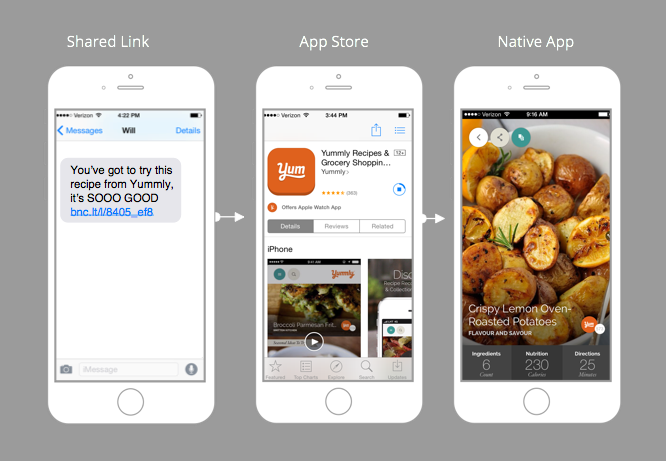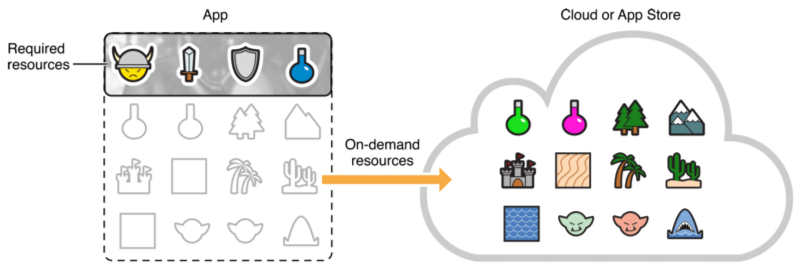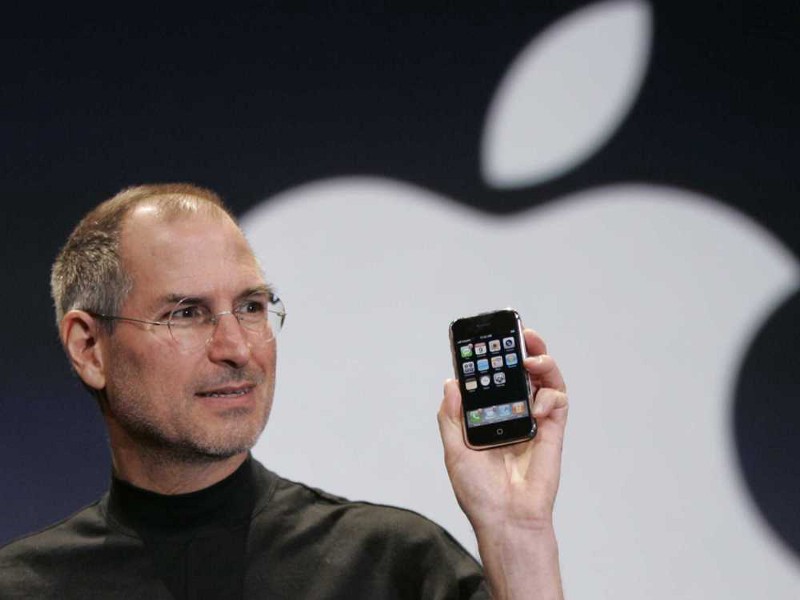There is no place for mobile applications in our future
- Transfer

Welcome to iCover Blog ! Perhaps in the near future we will no longer need to install applications - using Google and, much more surprisingly, not without the help of Apple.
Remember the slogan “There's an App for That”? Without exaggeration, he defined the vector of the development of the mobile world since 2008. Of course, then the applications seemed the only right direction. How mushrooms after rain appeared ways to develop applications in a couple of weeks; products began to roll commercials dedicated to their new applications; Damn, even our family restaurant around the corner got its own menu app.
With the advent of the App Store in 2008, Apple was the first to popularize the idea of beautifully packaged, easy-to-download apps on the phone. However, this concept of centralized software delivery is not really new. Many portable and desktop devices already had their own app stores built years before Apple's App Store debut. The reason Apple was able to replicate their success, in retrospect, is a good combination of time and technology. By 2008, the iOS (then “iPhone OS”) platform was able to offer access to the 3G network, a well-documented development environment, beautiful graphics, and most importantly, support from the technology giant. There was a reason to create mobile applications. They were the most effective way to deliver the latest content and services,
People by and large do not care how it all works, they just want to throw birds at pigs and sit on social networks. The ability to download and run cool apps has been a winning feature of the iPhone for a very short time. Android soon followed suit, then smartphones became cheaper; networks are faster; computing power has increased at times; applications flourished.
“So what is the problem then?”
Actually there is no problem. But we can do better! You ask: “ What, is there a way to improve my favorite application that allows me to feed and play virtually with cute kittens? ” Answer: “ Yes .” The fact is that mobile applications have become a good format due to the right combination of fast network and powerful portable processors. Technology has progressed much further since then, and the application world has grown to enormous proportions. Among all the headaches that are plaguing the mobile market today, there are two of the most pressing ones - delivery and accessibility of content.
Delivery and Availability
Each person with a smartphone once experienced this at some point: “ Wow, this restaurant or store offers a 20% discount! ... oh, but only if you have their application ” or “ Wait, I have to download the whole application in order to just to see what my friend wrote to me? "(hello, Facebook Messenger!); or " You must have heard from friends or seen ads about this really cool application that will change your life, but is it worth it to buy to install, or even worse, then pay a monthly fee for using it? ".

This long road to fried potato photography ...
This problem can be divided into two components. Let's start with the first one: delivery. The modern user has a short attention span and little patience. Paying for and installing an application that was once something magical, fast, and a new experience is an act of commitment for many nowadays. You will not believe how many people require a compelling reason, and how terribly much effort is needed to get them to try a new application. Just remember, you probably have one friend who still flatly refuses to download the Facebook Messenger app (seriously, just make him install it). Companies want easy delivery of content and services to customers, as fast and easy as possible. but the growing unwillingness to install a new application becomes an obstacle and sabotages the whole process. Our home smartphone screens are becoming a battleground - all applications claim first place!
The second issue, accessibility and openness of content, is a bit more complex, but it has been well-formulated by several IT journalists in the past. Many popular applications, such as Instagram and The Daily, began their careers as exclusively mobile applications, available only within a specific closed platform. You definitely had to download the application and register an Instagram account in order to see Instagram photos of your friends. I’m sure that there are still a lot of such applications, and we just pass by useful content that is not available for searching or viewing in our browser. A fragmented Internet where creativity and original content are locked inside proprietary platforms is not the Internet that we know and love.
GIF

The connection between applications and their indexing works, but out of hand
Now that we understand the problem, let's look at the existing solutions. The phrase “app linking” may seem unfamiliar at first glance, but every time you click on the YouTube link in another application and the YouTube’s native application opens for video playback, this is just the connection between the applications. Google, Apple, and Facebook use various implemented versions of this technology. The connection between applications allows you to use exactly the application that will best cope with the desired content. Well that sounds great.
The other half of our existing solution is application indexing. Google and Apple have provided ways for content providers and other third-party companies to showcase their own application content in a search query, which allows previously closed content to be visible in Google and iOS Spotlight searches.
That too is great in itself! At first glance, this solves our delivery and availability problems. The user is looking for something, the application shows its content in the search results, the user clicks on the link and receives the necessary information in the application.
You may already have noticed problems here. What if the application does not support such indexing? Indexing applications requires a content provider, efforts must be made to implement accessibility, so by default your content is not visible on the World Wide Web, as opposed to most of all web content. Until recently, in order for your application to be indexed by Google, developers had to build a mirror image of it - a web version. Just imagine these labor costs. And on the consumer side, what if I don’t have the right application? What if I do not want to install this application to just read the article? The list goes on.
GIF

Remember the moment when you tried to check something, and instead you are redirected to the application page in the App Store or Google Play. Oh, it's annoying. And no, no one wants to suddenly install another one-time application.
I don’t want to build a wall of applications on the screen at all. I want to consume and create content!
“ Well, then what to do? ”
You just need to get rid of “applications.” Let's see how this can be implemented.
Broadcast apps from Google
Google’s approach to delivery and availability is based on indexing applications and the relationship between them. If a developer makes an effort, users can see the content in the Google search results. This is a great opportunity for Google to keep their search relevant in the mobile market, which is increasingly dependent on the native content of the application instead of web search. But in countries such as China and India, where mobile phones are the first computers for millions of people and mobile content is the only main and important phrase, the phrase "all you are looking for is just one Google search from you" loses its magic.
GIF

A few months ago, Google showed off impressive technologies that did not arouse much interest - application translation (Google App Streaming). The name of this technology corresponds to the essence of its work; instead of installing applications in the usual way, after clicking on the link, Google will broadcast the necessary part of the application to you on demand. There is no need to install it, because you are already working on it. Perhaps this is just a pilot experiment by Google to develop their cloud platform, the idea of streaming applications for the phone is not new. Moreover, the technology itself was bought by Google from Agawi several years ago. But if you properly combine streaming and indexing the application, you will remove both barriers to information previously locked in mobile applications.
On Demand Resources from Apple
While Google’s fantastic solution is still in an experimental phase, Apple is pushing its developers in the same direction, but (which is typical for Apple), in a less explicit form or in more workarounds.
On-Demand Resources is a technology introduced with the 9th version of iOS, when only a small kernel of the application is loaded during the first installation, and additional parts and content are downloaded as needed. Currently, this is mainly used in games where the user downloads resources (graphics, video, etc.) and only a few initial levels. iOS will load more levels on its own as the user progresses and removes completed levels to save space.

Much in common with Google's approach? No, actually. However, if resources on demand become commonplace, and the supporting infrastructure is flexible enough, one can imagine how Apple can take advantage of this, expanding the scope of this approach for a more general use case. In any case, this is a wonderful tool that will potentially find its application in the form of applications that do not require "installation" in the usual form.
Undervalued Web Applications
While we are talking about Apple, I want to recall the presentation of the first iPhone from Steve Jobs. It is not difficult to recall that the very first iPhone was a closed platform without any development environment and without third-party applications. What solution did Steve offer? This is a web application.
Web applications do not require installation. They run in a (relatively) reliable, closed browser environment. They are web-friendly - they can be indexed and found by search engines. Oh, wait a minute, isn't that what we're aiming for today? It is difficult to answer unambiguously.

I am still convinced that web applications were just a plan for switching to native applications, but even in this case (even if it was a coincidence), they themselves represented something more. If in 2008 we had such powerful frameworks as we have today, perhaps web applications would not have suffered such a fate. Do not be shy to write about the fact that Jobs most likely anticipated upcoming problems of accessibility and delivery of applications, because the bet on web applications was an attempt to avoid this situation in the bud.
A future without apps
Many applications compete with other sophisticated technologies that are used in web applications (React Native and others), but the gap between native and web applications is rapidly narrowing. Nevertheless, one of the decisive factors of differentiation remains the visual differences between native and web applications, and the performance of web applications is still sorely lacking. An ideal solution still does not exist.
In addition to all this, we really need a Solomon solution for video streaming applications that will radically solve the problems of delivery and accessibility of such content. We need something similar to Java applets in browsers, but for smartphones. Imagine the possibilities: regardless of the operating system or brand of the supersmartphone in your pocket, you will be able to launch applications and view its contents - without discomfort and with the same performance as any native application. As for the developers, the benefits are completely obvious - you can write the application once and “broadcast” it all types of devices and browsers.
With the help of streaming applications from Google and thanks to Apple’s decision to push developers to store part of their applications in the cloud, we may have started an irreversible journey to the option of the future where “installation” will become an outdated concept and the border between the “website” and the “native application "will be completely blurred. This is our future without applications. And that's great.
Other iCover Articles and Events
- Overview of Netatmo Welcome Camera. Good Big Brother
- KitchenAid Spring Discounts
- Sale of useful gadgets and interesting pieces
- Jawbone UP3 vs. Xiaomi Mi Band 1S Pulse - the battle for our hearts!
- A selection of smart watches today. What changed?
- Spring discounts on Onkyo Hi-Fi appliances
- Logitech gives Tom Clancy's the Division
